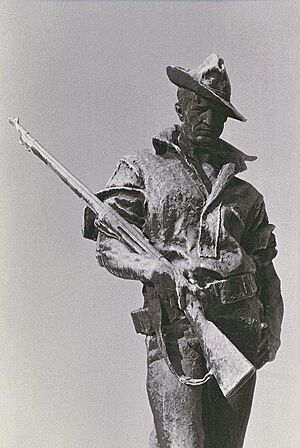The Hiker (Newman) facts for kids

The Hiker is a famous statue made by Allen George Newman. It was created to honor American soldiers. These soldiers took part in tough "long hikes in steaming jungles" during several wars. These included the Boxer Rebellion, the Spanish–American War, and the Philippine–American War.
The statue was first shown in New York at the 1907 Jamestown Exposition. Many groups of United Spanish War Veterans chose it. They wanted to set it up as a special memorial for war heroes.
A famous sculptor and critic, Lorado Taft, called it "The best bronze soldier in America." Because it was so popular, many copies were made. You can find these statues in many cities across the country. A company called Jno. Williams, Inc. in New York City was the only one allowed to make the statues from "real bronze." The sculptor, Newman, even offered free advice on how to design the statue's base.
Contents
What Does the Hiker Statue Look Like?
The Hiker statue shows a strong American soldier. He looks ready for anything. His head is held high, and his shoulders are broad. He has a full chest and a lean body. His legs look very muscular, showing he can march for a long time.
The soldier holds his Krag rifle in a ready position. It looks like he knows how to use it well. His face is clean-shaven, which was common back then. Every part of the statue is strong and clear. It shows a disciplined soldier, ready to face challenges.
Where Can You Find The Hiker Statues?
Many cities have a copy of The Hiker statue. They serve as important reminders of the soldiers who served. Here are some of the places where you can see them:
- Utica, New York: The Munson-Williams-Proctor Arts Institute has a smaller version from 1904. This was the first bronze copy made from Newman's original model.
- New York City, New York: The New-York Historical Society also has a small copy from 1904.
- Providence, Rhode Island: The first large memorial statue was placed here on Memorial Day in 1912. It is in the North Burial Ground.
- Staten Island, New York: Another statue was put up in 1912. It was later moved to Tompkinsville Park in 1925.
- Bayonne, New Jersey: The third memorial statue was installed here on Labor Day in 1912.
- Newark, New Jersey: A statue was placed in Hiker Park in 1914. Sadly, it was stolen in 1980 and badly damaged. Only the base remains.
- Utica, New York: A larger statue was installed here in 1915.
- Buffalo, New York: A statue was placed in Roosevelt Plaza in 1920.
- Pawtucket, Rhode Island: You can find a statue in Grove Street Park, installed in 1922.
- Saratoga Springs, New York: A statue was placed in Greenridge Cemetery in 1923.
- Southbridge, Massachusetts: A statue was installed here in 1923.
- Westerly, Rhode Island: A statue was placed in Wilcox Park in 1924.
- Pittsburgh, Pennsylvania: A statue stands near the Frick Fine Arts Building from 1925.
- Woonsocket, Rhode Island: A statue was placed in Court Square in 1925.
- Bristol, Connecticut: This city has two statues! The first was from 1929, and a copy was added in 1983.
- Ypsilanti, Michigan: A statue was installed here in 1940.
Hiker Reliefs and Plaques
Many memorials for the Spanish–American War also include a special bronze relief. A relief is a type of sculpture where the figures stick out from a flat background. These reliefs often show Newman's Hiker statue in front of the battleship Maine.
Below the statue on these reliefs, you might see the words, "Hiker of '98." They also often include a quote from President William McKinley: "You triumphed over obstacles which would have overcome men less brave and determined."
Some of these bronze plaques also say, "Every Man a Volunteer." They might even show the number 458,151. This number represents the total number of U.S. service members who fought in the war with Spain, the Philippine–American War, and the Boxer Rebellion.
These bronze plaques were made by the Lamb Seal and Stencil Company. It was started in 1900 by Richard L. Lamb. He was an immigrant from Britain who fought in the Siege of Santiago in Cuba during the Spanish–American War.
Images for kids













